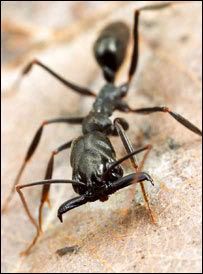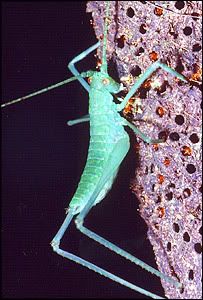Trap-jaw ant

Ants are found in almost every habitat on Earth, and in some numbers - there are an estimated 1,000 trillion ants living on the planet at any given moment, representing 11,800 known species. The total weight of all ants on the planet roughly equal the weight of us humans. Articles like this one prove how spectacular they can be. The Trap-jaw Ant springs it's mouthparts shut at over 100kmh (60mph), the fastest recorded moving predatory body part in the animal kingdom (now there's an awards ceremony to avoid). In typical adaptive fashion, the ants don't just use this to impress lady ants, they use it to move around. The ants sometimes bite the ground, the force of which pings them upwards and launches them several centimetres. They are too light to be injured by the fall - the equivalent of us jumping hundreds of feet - and don't just do it move around, the 'popcorn' effect of many leaping ants confuses would-be predators.
The trap is sprung

Ants also dominate the other land-living invertebrates, making up one-third of the global insect biomass. In tropical rainforests they can compromise an amazing 15% of the total biomass of animals found there. They can be as tiny as the millimeter-long Oligomyrmex atomus or as big as the 1.5 inch-long Dinoponera. We've all seen nature documentaries of rampaging tides of jungle Army Ants wiping clean strips of forest floor, causing even large mammals to flee before them. But there are other, more inventive ways these creatures catch their dinner. Some of them construct elaborate 'torture chambers', using a specially-cultivated fungus. Allomerus decemarticulatus, only 2mm long, cut hairs from the stem of the plant they inhabit, and weave the fibres into a spongy snare which they glue into place using the sticky mould. The ants nibble small holes in this fake platform, and a worker sits patiently in each, jaws at the ready. Anything landing on the 'branch' with thin enough legs is immediately grabbed, and pulled into several holes at once, trapping it. Other ants then swarm out from under the platform and butcher the victim, which has been stretched out like on a medieval rack. First reported in Nature, there are amazing pictures of the behaviour here.
Gliding Ant

Ants evolved from the Vespoid group of wasps in the Cretaceous period about 120 to 170 million years ago. Only about 1 in 10 genera alive then is extinct now. To become such a successful group of animals, you need to be intelligent and able to adapt to your habitat. Ants commonly live in trees, scampering in orderly lines along branches. If they fall, or are knocked off (or flicked off by scientists), they face almost certain death alone on the forest floor prowled by many predators not found in the canopy. So one type of ant has evolved a large head (nicknamed the 'Darth Vader' ant) to combat this - and teeth to get back at the scientists (photo above). The ant falls for a few metres, then swivels in the air to orient it's abdomen towards the tree trunk. The air flowing over the large head slows down the tumbling ant, and swing it's trajectory inwards, causing it to sail back to the tree and land safely. This is the first documented example of gliding flight in a living wingless insect, and the first record of intentional backwards gliding in any animal. Link
Tandem running in action

While many types of animals can learn behaviors by imitating other animals, ants may be the only group of animals besides mammals in which interactive teaching behavior has been observed. When Temnothorax albipennis forager ants find a food source they scuttle back to the nest and grab a hivemate. They then lead the new ant to the food in a process called 'tandem running'. The ant in front darts off to the food, but the new ant slows up now and again to fix it's positon by spotting landmarks. The first ant has to keep stopping and waiting to be caught up - having it's legs tapped when the second ant has memorised where it is and is ready to continue. This takes far longer than if the sole ant ran backwards and forwards to the food - but now two ants know where it is, and often the followers become guides to other ants in turn, and soon the colony as a whole knows where the booty is. The teamwork these creatures show is amazing. Sometimes they decide the foodstuff is too juicy to adopt this clever but costly technique, and returning ants simply grab another and carry it on it's back to the goodies. The second ant won't know the route to the prize, but the ants will get there quickly and secure their food before other colonies arrive to claim it. This remarkable adaptability sets ant apart. If they ever learn to use guns and drive tanks, we're done for...
Why ants rule the world
Ants on Wikipedia
Ant photos